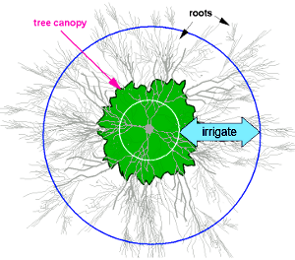water
Goal
The feeding roots of a tree or shrub are located within the top 12 inches of the soil and at the dripline of the plant (the area directly below the outermost reaches of the branches). The goal of efficient watering is to periodically moisten all of the soil and feeding roots. This is much easier to accomplish in a good loam soil, where water passes evenly through to the subsoil layer at a rate that is slow enough for root uptake but not so slow that the roots drown. In less ideal soils, be careful not to exclude air from the root zone for a prolonged period.
Method
| Individual plants | hand-held hose or watering can |
| Small groups | drip hoses or lines with individual drip heads |
| Large beds | drip hoses |
| Lawns | oscillating sprinklers |
Trees
Apply water just inside and a little beyond the dripline rather than at the trunk. Irrigating the area directly adjacent to the trunk of an established tree can increase the risk of disease and provides no benefit because of the way feeder roots are distributed.
Because roots extend far beyond the edge of the canopy, it is much better to water the outer half of the area under the canopy and far beyond the canopy edge, usually 3X the diameter of the tree canopy. Simply lay a slowly running hose on the ground and move it around the dripline as each area becomes saturated to a depth of 8–10 inches. For large trees, this may take several hours.
 Vacaville Tree Foundation How to water your tree
Vacaville Tree Foundation How to water your tree
Large areas
For large areas, consider irrigation methods that reduce water lost as mist. For example, drip hoses have low mist loss while oscillating sprinklers can have high mist loss, especially during windy periods.
Timing
Watering when it is cool reduces evaporative loss. The hours just before or just after dawn are ideal. Because this is also when foliage is already wet with dew, watering near dawn does not encourage disease development.
Frequency
Water before the plant is wilted in the morning
Many plants droop temporarily during the heat of the day, but will recover over the evening. A simple finger test can help you to decide: insert your finger into the soil or use a screwdriver to probe down about 4 inches. You can determine by touch the degree and depth of soil moisture.
Water deeply but infrequently
Shallow watering keeps the moisture near the surface, causing plant roots to grow near the surface where they are subject to stress from surface drying. Less frequent but longer watering provides a deep wet zone that promotes deep root growth.
Water more frequently during the ‘critical period’
Plants are particularly sensitive to moisture stress during the critical period. Flowering and fruiting stages are common critical periods for ornamentals, while turfgrass crowns coming out of winter dormancy are especially susceptible to dehydration at time of ‘green-up’. Because our springs tend to be dry, turfgrass often requires irrigation in early spring when day temperatures are warm but night temperatures are still cool.
Amount
For lawns and perennials, soil should be wetted to a depth of 4–6″. This requires an application of about 1 inch by overhead irrigation in our Piedmont soils. Note that the amount of water needed varies with the application method because loss to evaporation and runoff differs.
Monitoring
Overhead water
A small, straight-sided container such as a tuna can, placed level on the surface to be measured, can serve as a simple rain gauge to monitor either rain or an overhead sprinkler. The depth of water in the container indicates the amount. For example, after a 1 inch rainfall the water in the can will be 1 inch deep.
Soaker hose
Use your finger or a screwdriver to probe 4–6″ deep.
Automated irrigation system
Include a rain-sensor in an automated irrigation system to avoid unneeded supplemental watering during rainy periods.
